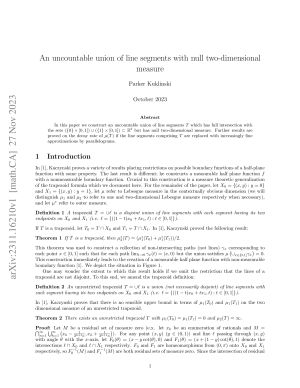Parker Kuklinski
An uncountable union of line segments with null two-dimensional measure
Image copy
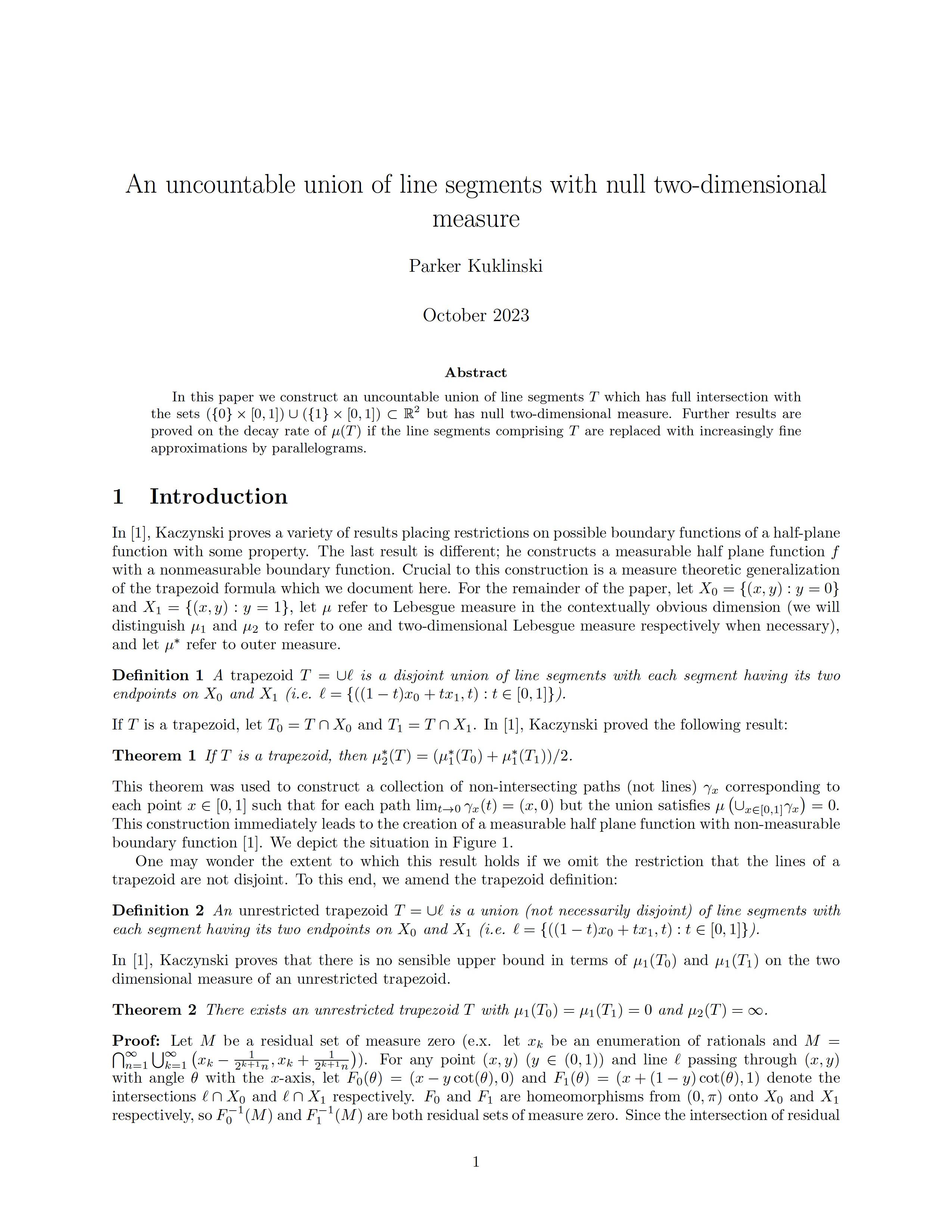
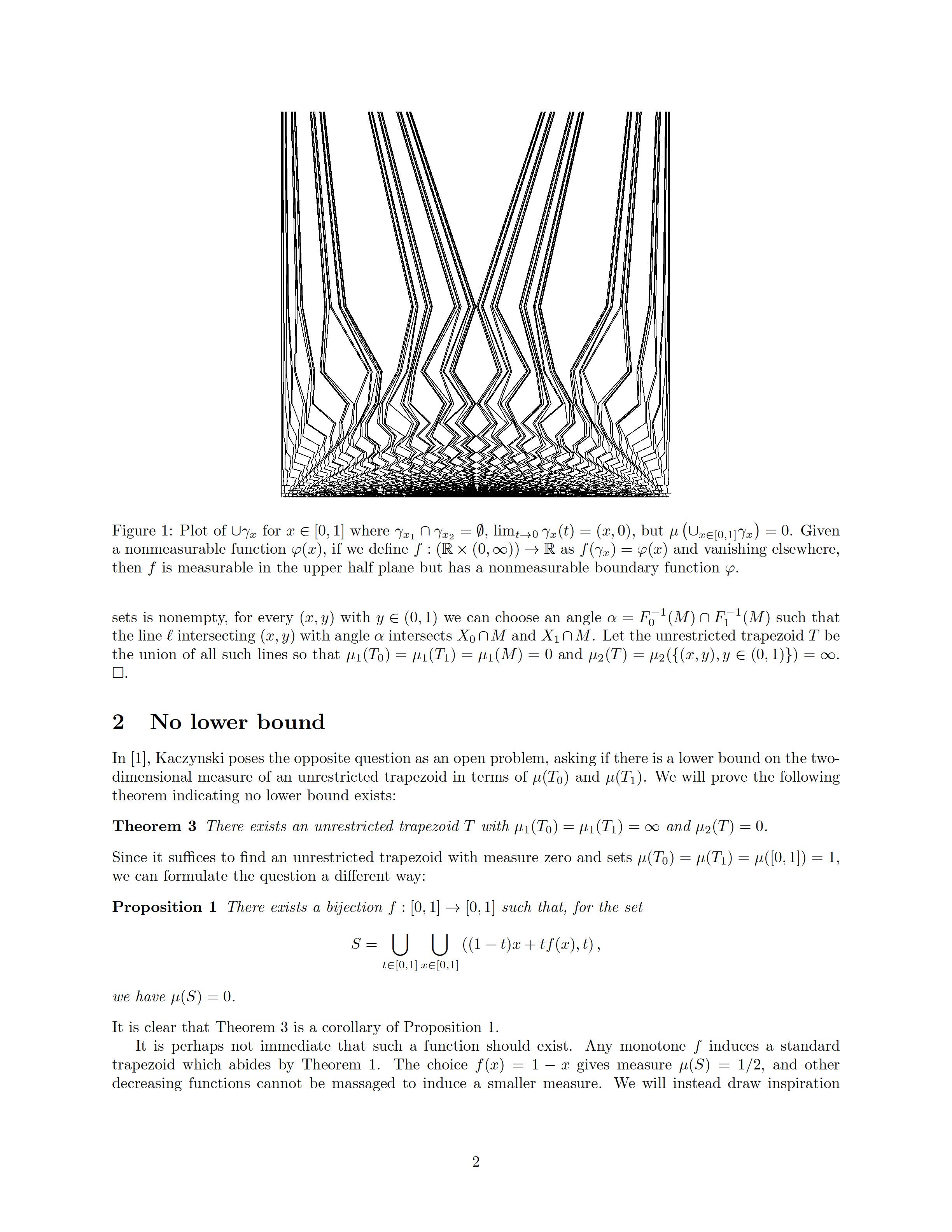
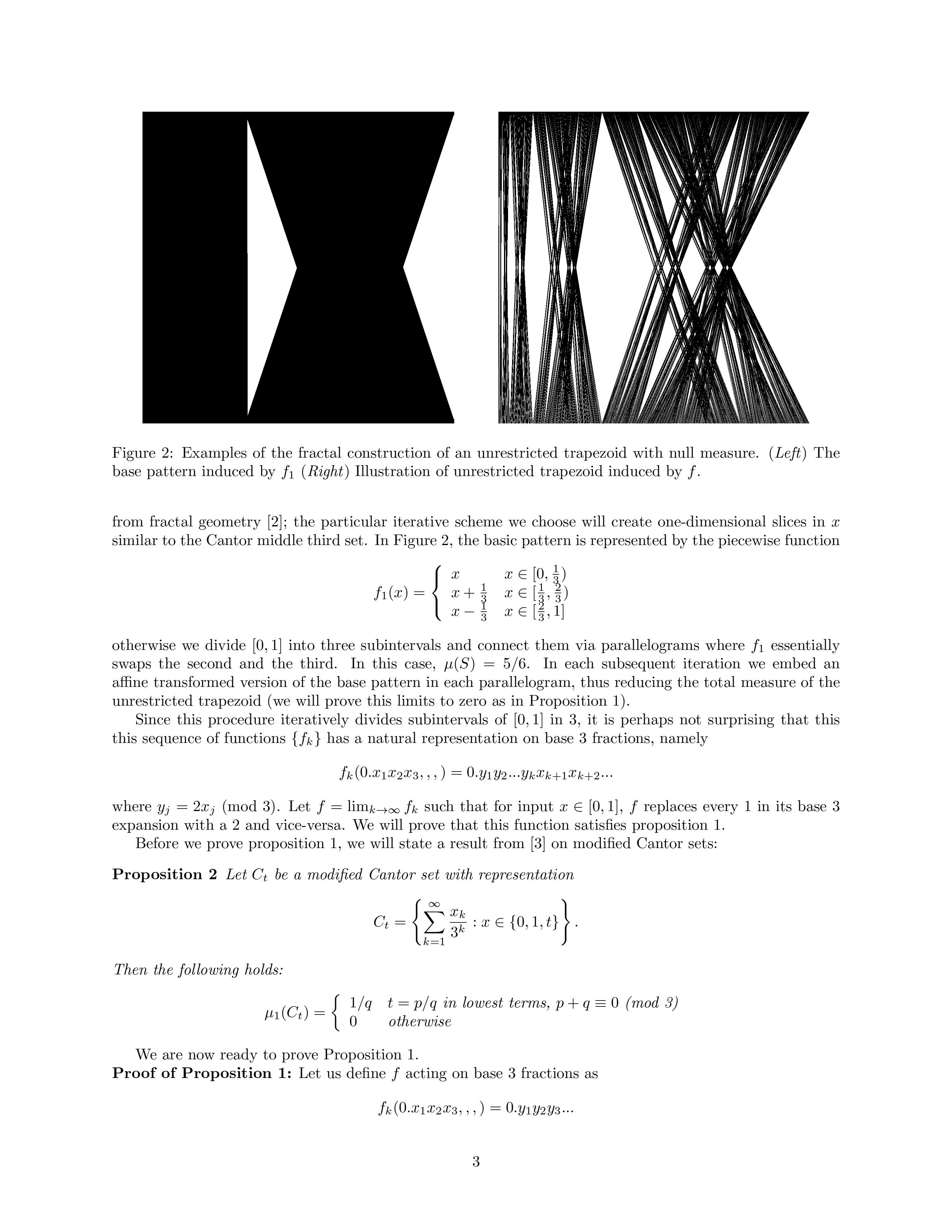
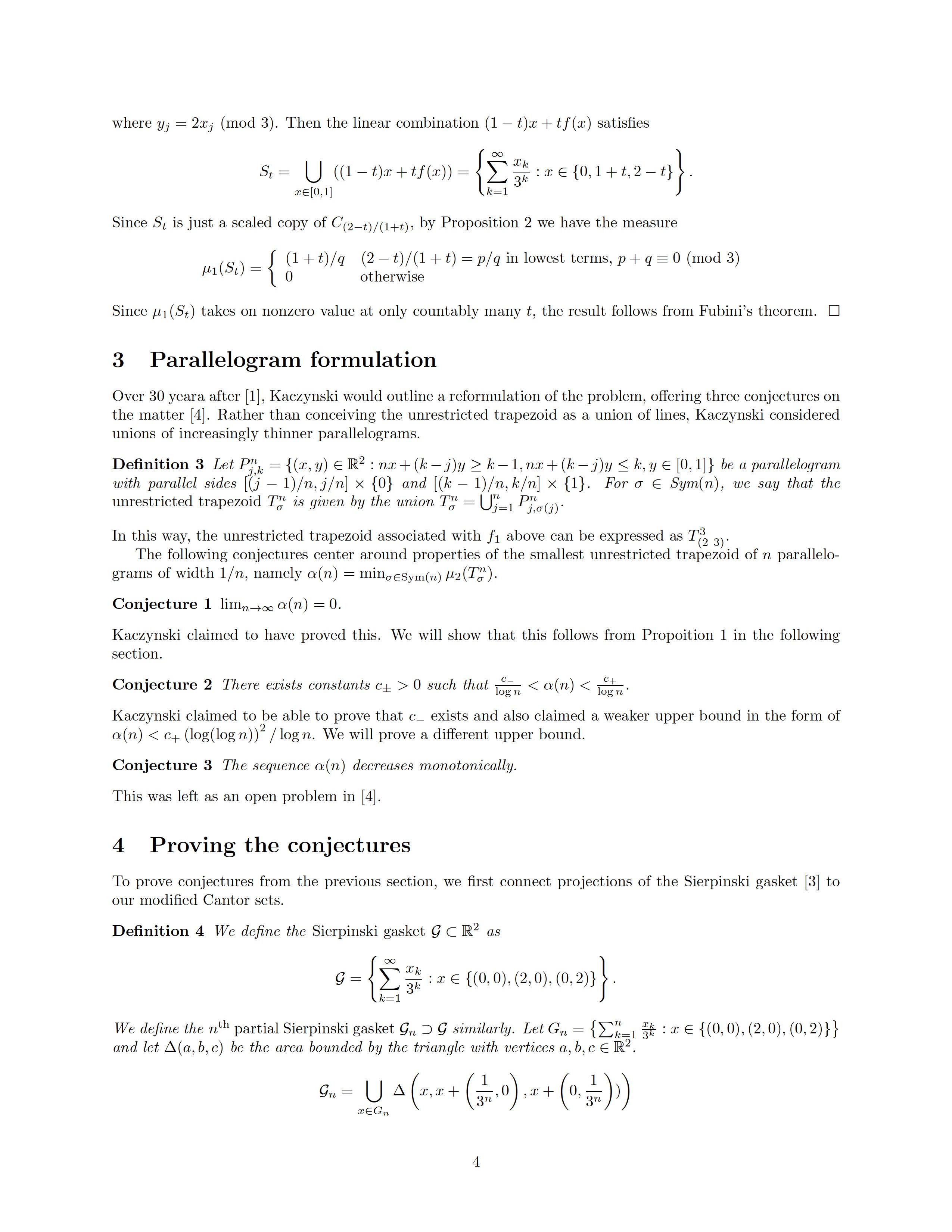
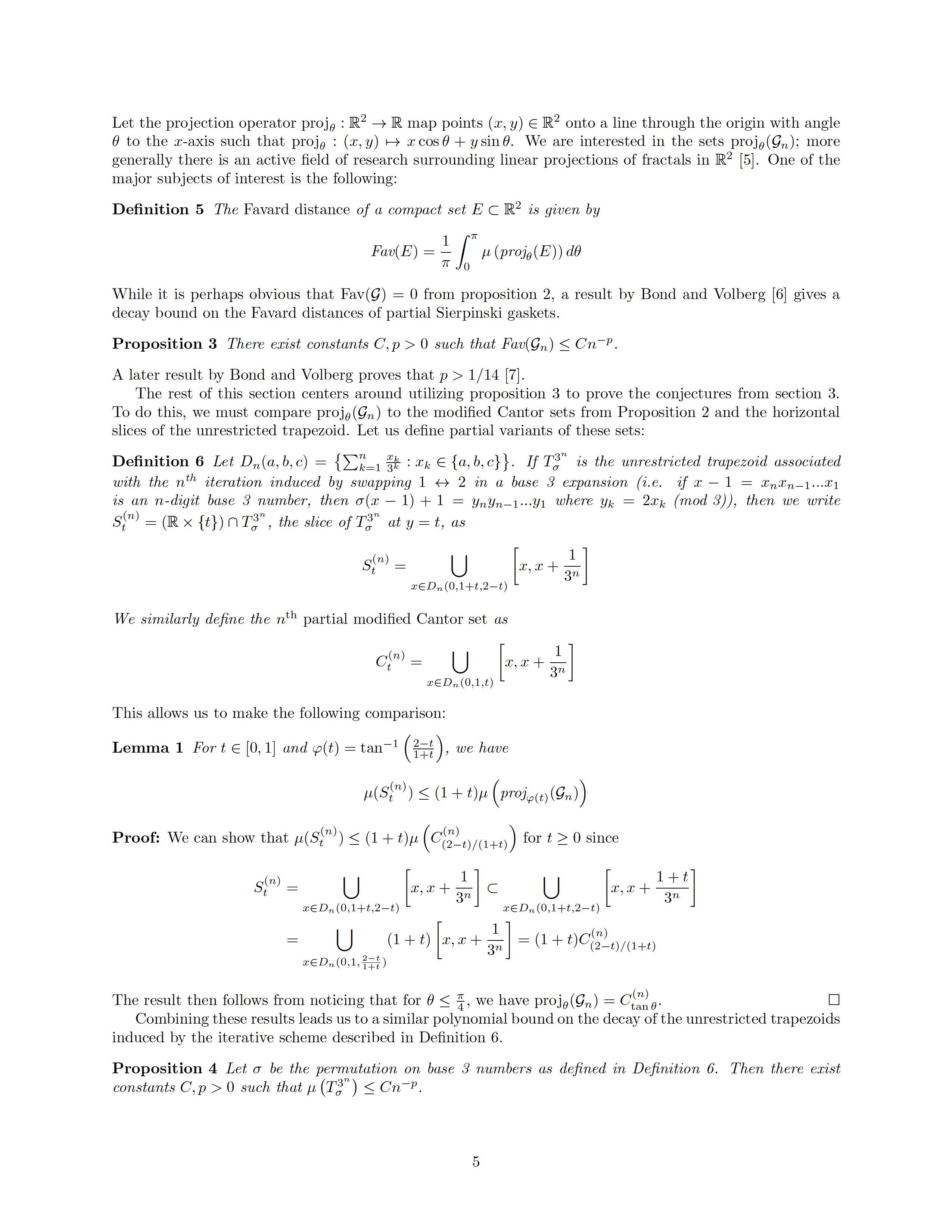
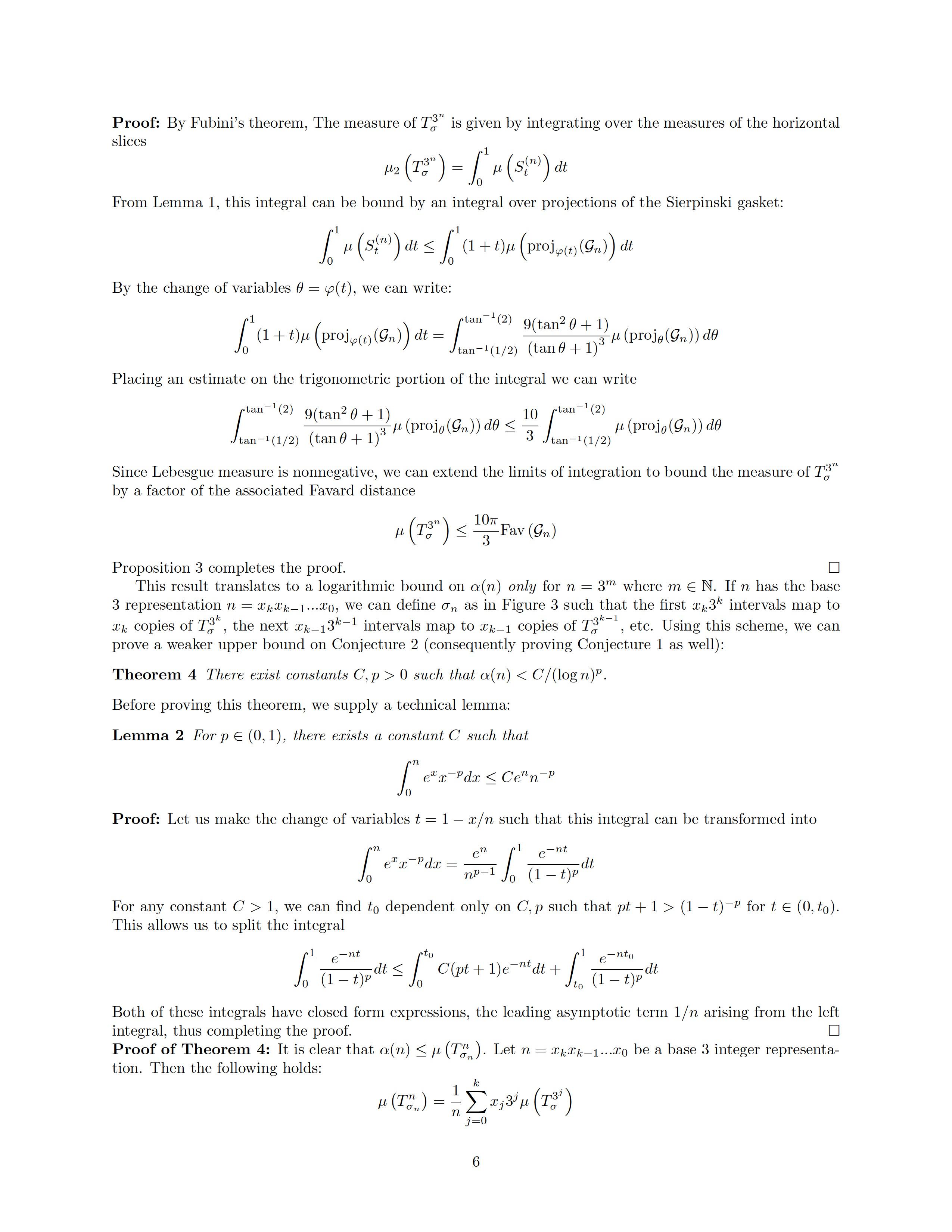
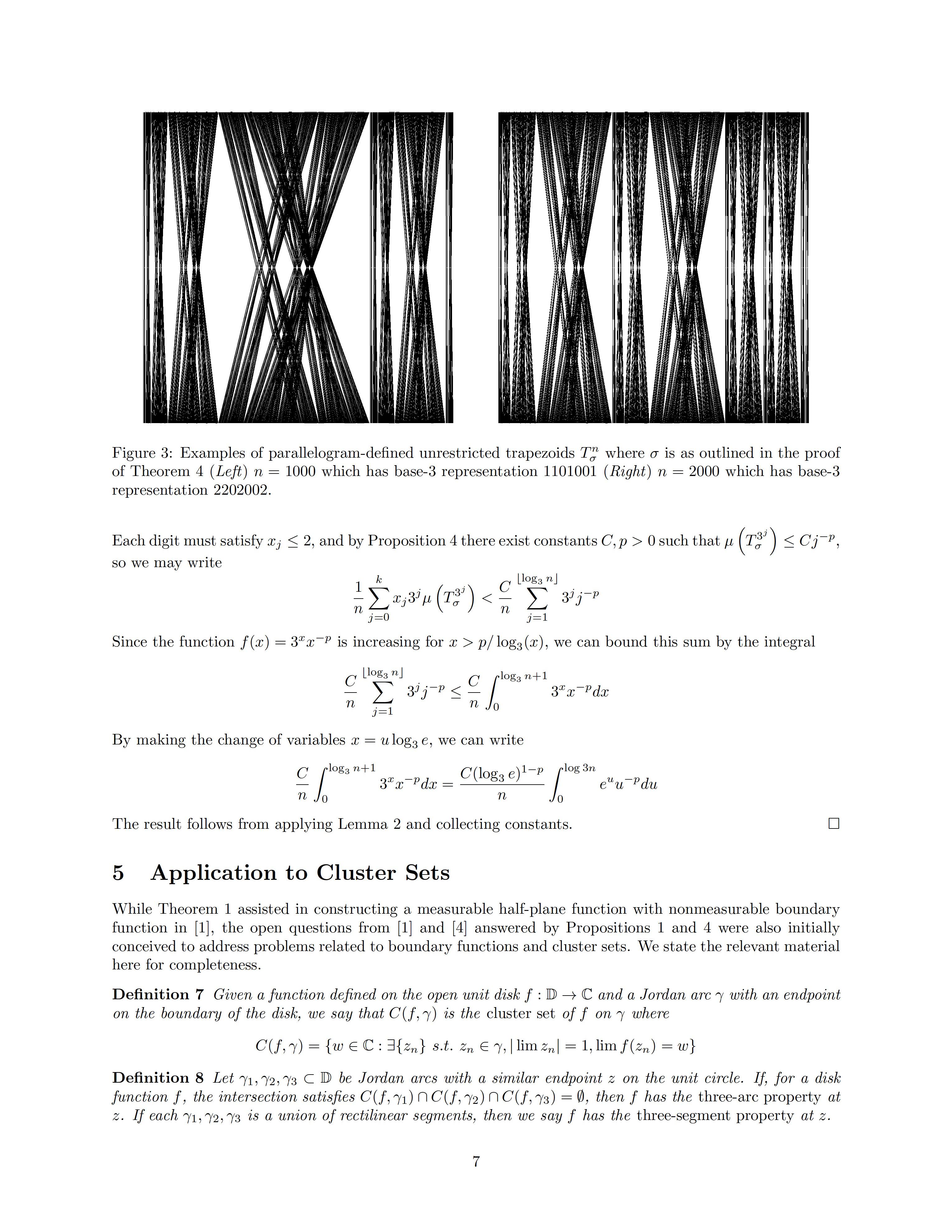
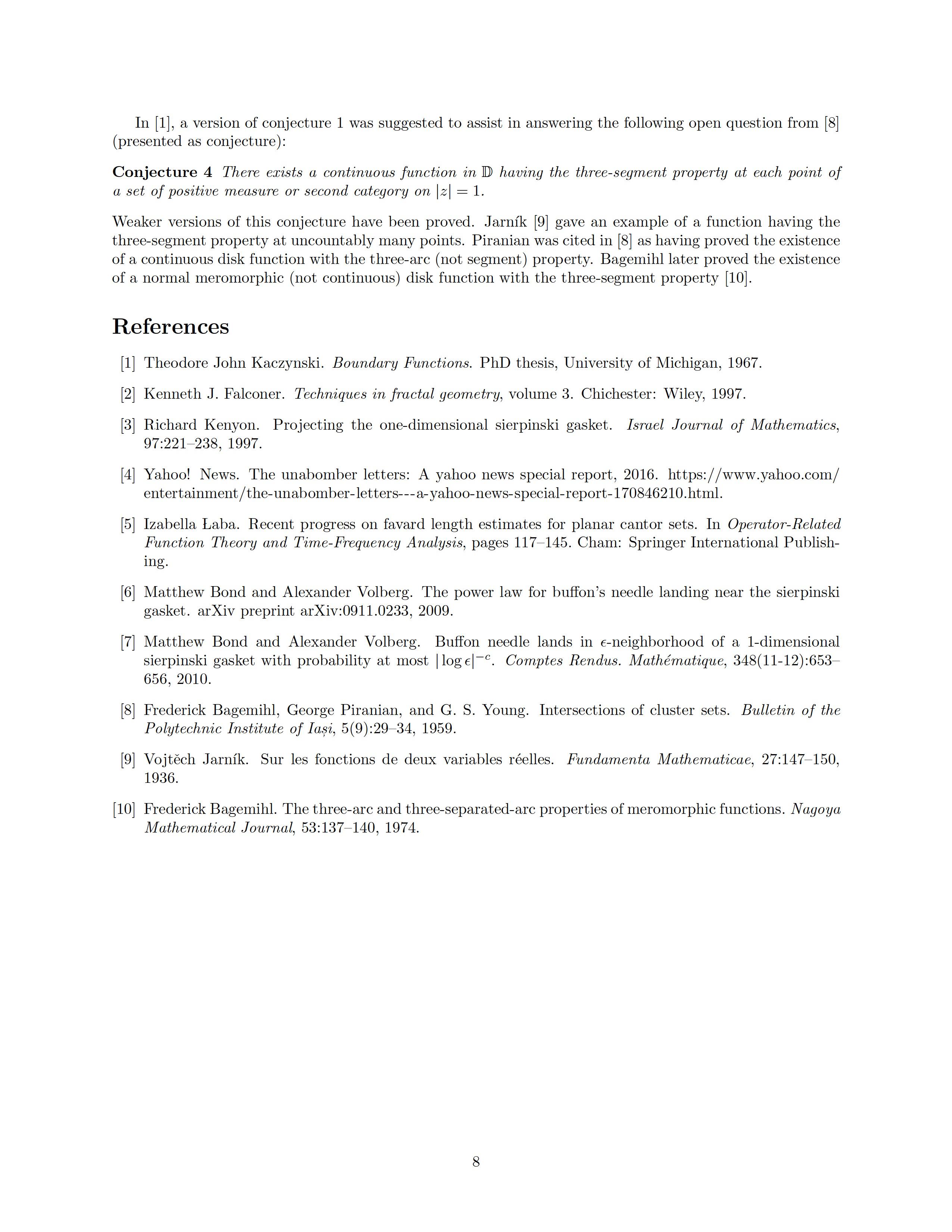
Text copy with conversion errors
The version below contains many errors where symbols haven't been converted to html correctly, but it may be useful for word searching, such as being able to click the hyperlinked references at the end of the document and helping this document show up in searches.
Abstract
In this paper we construct an uncountable union of line segments T which has full intersection with the sets ({0 }× [0,1]) ∪ ({1 }× [0,1]) ⊂ R2 but has null two-dimensional measure. Further results are proved on the decay rate of µ(T) if the line segments comprising T are replaced with increasingly fine approximations by parallelograms.
1. Introduction
In [1], Kaczynski proves a variety of results placing restrictions on possible boundary functions of a half-plane function with some property. The last result is different; he constructs a measurable half plane function f with a nonmeasurable boundary function. Crucial to this construction is a measure theoretic generalization of the trapezoid formula which we document here. For the remainder of the paper, let X0 = {(x,y) : y = 0} and X1 = {(x,y) : y = 1}, let µ refer to Lebesgue measure in the contextually obvious dimension (we will distinguish µ1 and µ2 to refer to one and two-dimensional Lebesgue measure respectively when necessary), and let µ∗ refer to outer measure.
Definition 1 A trapezoid T = ∪ℓ is a disjoint union of line segments with each segment having its two endpoints on X0 and X1 (i.e. ℓ = {((1 − t)x0 + tx1,t) : t ∈ [0,1]}).
If T is a trapezoid, let T0 = T ∩ X0 and T1 = T ∩ X1. In [2], Kaczynski proved the following result:
Theorem 1 If T is a trapezoid, then .
This theorem was used to construct a collection of non-intersecting paths (not lines) γx corresponding to each point x ∈ [0,1] such that for each path limt→0 γx(t) = (x,0) but the union satisfies
This construction immediately leads to the creation of a measurable half plane function with non-measurable boundary function [3]. We depict the situation in Figure 1.
One may wonder the extent to which this result holds if we omit the restriction that the lines of a trapezoid are not disjoint. To this end, we amend the trapezoid definition:
Definition 2 An unrestricted trapezoid T = ∪ℓ is a union (not necessarily disjoint) of line segments with each segment having its two endpoints on X0 and X1 (i.e. ℓ = {((1 − t)x0 + tx1,t) : t ∈ [0,1]}).
In [4], Kaczynski proves that there is no sensible upper bound in terms of µ1(T0) and µ1(T1) on the two dimensional measure of an unrestricted trapezoid.
Theorem 2 There exists an unrestricted trapezoid T with µ1(T0) = µ1(T1) = 0 and µ2(T) = ∞.
Proof: Let M be a residual set of measure zero (e.x. let xk be an enumeration of rationals and M =
). For any point (x,y) (y ∈ (0,1)) and line ℓ passing through (x,y)
with angle θ with the x-axis, let F0(θ) = (x − y cot(θ),0) and F1(θ) = (x + (1 − y)cot(θ),1) denote the intersections ℓ ∩ X0 and ℓ ∩ X1 respectively. F0 and F1 are homeomorphisms from (0,π) onto X0 and X1 respectively, so) are both residual sets of measure zero. Since the intersection of residual
Figure 1: Plot of ∪γx for x ∈ [0,1] where γx1 ∩ γx2 = ∅, limt→0 γx(t) = (x,0), but = 0. Given a nonmeasurable function φ(x), if we define f : (R × (0,∞)) → R as f(γx) = φ(x) and vanishing elsewhere, then f is measurable in the upper half plane but has a nonmeasurable boundary function φ.
sets is nonempty, for every (x,y) with y ∈ (0,1) we can choose an angle) such that the line ℓ intersecting (x,y) with angle α intersects X0 ∩M and X1 ∩M. Let the unrestricted trapezoid T be the union of all such lines so that µ1(T0) = µ1(T1) = µ1(M) = 0 and µ2(T) = µ2({(x,y),y ∈ (0,1)}) = ∞. □.
2. No lower bound
In [5], Kaczynski poses the opposite question as an open problem, asking if there is a lower bound on the twodimensional measure of an unrestricted trapezoid in terms of µ(T0) and µ(T1). We will prove the following theorem indicating no lower bound exists:
Theorem 3 There exists an unrestricted trapezoid T with µ1(T0) = µ1(T1) = ∞ and µ2(T) = 0.
Since it suffices to find an unrestricted trapezoid with measure zero and sets µ(T0) = µ(T1) = µ([0,1]) = 1, we can formulate the question a different way:
Proposition 1 There exists a bijection f : [0,1] → [0,1] such that, for the set
S = [ [ ((1 − t)x + tf(x),t),
t∈[0,1] x∈[0,1]
we have µ(S) = 0.
It is clear that Theorem 3 is a corollary of Proposition 1.
It is perhaps not immediate that such a function should exist. Any monotone f induces a standard trapezoid which abides by Theorem 1. The choice f(x) = 1 − x gives measure µ(S) = 1/2, and other decreasing functions cannot be massaged to induce a smaller measure. We will instead draw inspiration
Figure 2: Examples of the fractal construction of an unrestricted trapezoid with null measure. (Left) The base pattern induced by f1 (Right) Illustration of unrestricted trapezoid induced by f.
from fractal geometry [6]; the particular iterative scheme we choose will create one-dimensional slices in x similar to the Cantor middle third set. In Figure 2, the basic pattern is represented by the piecewise function
otherwise we divide [0,1] into three subintervals and connect them via parallelograms where f1 essentially swaps the second and the third. In this case, µ(S) = 5/6. In each subsequent iteration we embed an affine transformed version of the base pattern in each parallelogram, thus reducing the total measure of the unrestricted trapezoid (we will prove this limits to zero as in Proposition 1).
Since this procedure iteratively divides subintervals of [0,1] in 3, it is perhaps not surprising that this this sequence of functions {fk} has a natural representation on base 3 fractions, namely
fk(0.x1x2x3,,,) = 0.y1y2...ykxk+1xk+2...
where yj = 2xj (mod 3). Let f = limk→∞ fk such that for input x ∈ [0,1], f replaces every 1 in its base 3 expansion with a 2 and vice-versa. We will prove that this function satisfies proposition 1. Before we prove proposition 1, we will state a result from [7] on modified Cantor sets: Proposition 2 Let Ct be a modified Cantor set with representation
.
Then the following holds:
in lowest terms, p + q ≡ 0 (mod 3)
We are now ready to prove Proposition 1.
Proof of Proposition 1: Let us define f acting on base 3 fractions as
fk(0.x1x2x3,,,) = 0.y1y2y3...
where yj = 2xj (mod 3). Then the linear combination (1 − t)x + tf(x) satisfies
.
Since St is just a scaled copy of C(2−t)/(1+t), by Proposition 2 we have the measure
in lowest terms, p + q ≡ 0 (mod 3)
Since µ1(St) takes on nonzero value at only countably many t, the result follows from Fubini’s theorem. □
3. Parallelogram formulation
Over 30 yeara after [8], Kaczynski would outline a reformulation of the problem, offering three conjectures on the matter [9]. Rather than conceiving the unrestricted trapezoid as a union of lines, Kaczynski considered unions of increasingly thinner parallelograms.
Definition 3 Let be a parallelogram with parallel sides [(j − 1)/n,j/n] × {0 } and [(k − 1)/n,k/n] × {1 }. For σ ∈ Sym(n), we say that the unrestricted trapezoid is given by the union.
In this way, the unrestricted trapezoid associated with f1 above can be expressed as.
The following conjectures center around properties of the smallest unrestricted trapezoid of n parallelograms of width 1/n, namely
Conjecture 1 limn→∞ α(n) = 0.
Kaczynski claimed to have proved this. We will show that this follows from Propoition 1 in the following section.
Conjecture 2 There exists constants c± > 0 such that .
Kaczynski claimed to be able to prove that c− exists and also claimed a weaker upper bound in the form of α(n) < c+ (log(logn))2 /logn. We will prove a different upper bound.
Conjecture 3 The sequence α(n) decreases monotonically.
This was left as an open problem in [10].
4. Proving the conjectures
To prove conjectures from the previous section, we first connect projections of the Sierpinski gasket [11] to our modified Cantor sets.
Definition 4 We define the Sierpinski gasket G ⊂ R2 as
.
We define the nth partial Sierpinski gasket Gn ⊃ G similarly. Let and let ∆(a,b,c) be the area bounded by the triangle with vertices a,b,c ∈ R2.
Let the projection operator projθ : R2 → R map points (x,y) ∈ R2 onto a line through the origin with angle θ to the x-axis such that projθ : (x,y) 7→ xcosθ + y sinθ. We are interested in the sets projθ(Gn); more generally there is an active field of research surrounding linear projections of fractals in R2 [12]. One of the major subjects of interest is the following:
Definition 5 The Favard distance of a compact set E ⊂ R2 is given by
Fav
While it is perhaps obvious that Fav(G) = 0 from proposition 2, a result by Bond and Volberg [13] gives a decay bound on the Favard distances of partial Sierpinski gaskets.
Proposition 3 There exist constants C,p > 0 such that Fav(Gn) ≤ Cn−p.
A later result by Bond and Volberg proves that p > 1/14 [14].
The rest of this section centers around utilizing proposition 3 to prove the conjectures from section 3. To do this, we must compare projθ(Gn) to the modified Cantor sets from Proposition 2 and the horizontal slices of the unrestricted trapezoid. Let us define partial variants of these sets:
Definition 6 Let . If is the unrestricted trapezoid associated with the nth iteration induced by swapping 1 ↔ 2 in a base 3 expansion (i.e. if x − 1 = xnxn−1...x1 is an n-digit base 3 number, then σ(x − 1) + 1 = ynyn−1...y1 where yk = 2xk (mod 3)), then we write S(n)t = (R × {t}) ∩ Tσ3n, the slice of, as
We similarly define the nth partial modified Cantor set as
This allows us to make the following comparison:
Lemma 1 For t ∈ [0,1] and, we have
Proof: We can show that for t ≥ 0 since
The result then follows from noticing that for, we have proj. □
Combining these results leads us to a similar polynomial bound on the decay of the unrestricted trapezoids induced by the iterative scheme described in Definition 6.
Proposition 4 Let σ be the permutation on base 3 numbers as defined in Definition 6. Then there exist constants C,p > 0 such that .
Proof: By Fubini’s theorem, The measure of is given by integrating over the measures of the horizontal slices
From Lemma 1, this integral can be bound by an integral over projections of the Sierpinski gasket:
By the change of variables θ = φ(t), we can write:
(projθ(Gn))dθ Placing an estimate on the trigonometric portion of the integral we can write
(proj
Since Lebesgue measure is nonnegative, we can extend the limits of integration to bound the measure of by a factor of the associated Favard distance
Fav(Gn)
Proposition 3 completes the proof. □
This result translates to a logarithmic bound on α(n) only for n = 3m where m ∈ N. If n has the base 3 representation n = xkxk−1...x0, we can define σn as in Figure 3 such that the first xk3k intervals map to xk copies of, the next xk−13k−1 intervals map to xk−1 copies of, etc. Using this scheme, we can prove a weaker upper bound on Conjecture 2 (consequently proving Conjecture 1 as well):
Theorem 4 There exist constants C,p > 0 such that α(n) < C/(logn)p.
Before proving this theorem, we supply a technical lemma:
Lemma 2 For p ∈ (0,1), there exists a constant C such that
Proof: Let us make the change of variables t = 1 − x/n such that this integral can be transformed into
For any constant C > 1, we can find t0 dependent only on C,p such that pt + 1 > (1 − t)−p for t ∈ (0,t0). This allows us to split the integral
Both of these integrals have closed form expressions, the leading asymptotic term 1/n arising from the left integral, thus completing the proof.□
Proof of Theorem 4: It is clear that. Let n = xkxk−1...x0 be a base 3 integer representation. Then the following holds:
Figure 3: Examples of parallelogram-defined unrestricted trapezoids where σ is as outlined in the proof of Theorem 4 (Left) n = 1000 which has base-3 representation 1101001 (Right) n = 2000 which has base-3 representation 2202002.
Each digit must satisfy xj ≤ 2, and by Proposition 4 there exist constants C,p > 0 such that, so we may write
Since the function f(x) = 3xx−p is increasing for x >p/log3(x), we can bound this sum by the integral
By making the change of variables x = ulog3 e, we can write
The result follows from applying Lemma 2 and collecting constants. □ 5 Application to Cluster Sets
While Theorem 1 assisted in constructing a measurable half-plane function with nonmeasurable boundary function in [15], the open questions from [16] and [17] answered by Propositions 1 and 4 were also initially conceived to address problems related to boundary functions and cluster sets. We state the relevant material here for completeness.
Definition 7 Given a function defined on the open unit disk f : D → C and a Jordan arc γ with an endpoint on the boundary of the disk, we say that C(f,γ) is the cluster set of f on γ where
C(f,γ) = {w ∈ C : ∃{zn} s.t. zn ∈ γ,|limzn| = 1,limf(zn) = w}
Definition 8 Let γ1,γ2,γ3 ⊂ D be Jordan arcs with a similar endpoint z on the unit circle. If, for a disk function f, the intersection satisfies C(f,γ1) ∩ C(f,γ2) ∩ C(f,γ3) = ∅, then f has the three-arc property at z. If each γ1,γ2,γ3 is a union of rectilinear segments, then we say f has the three-segment property at z.
In [18], a version of conjecture 1 was suggested to assist in answering the following open question from [19] (presented as conjecture):
Conjecture 4 There exists a continuous function in D having the three-segment property at each point of a set of positive measure or second category on |z| = 1.
Weaker versions of this conjecture have been proved. Jarn´ık [20] gave an example of a function having the three-segment property at uncountably many points. Piranian was cited in [21] as having proved the existence of a continuous disk function with the three-arc (not segment) property. Bagemihl later proved the existence of a normal meromorphic (not continuous) disk function with the three-segment property [22].
References
[1] Theodore John Kaczynski. Boundary Functions. PhD thesis, University of Michigan, 1967.
[2] Theodore John Kaczynski. Boundary Functions. PhD thesis, University of Michigan, 1967.
[3] Theodore John Kaczynski. Boundary Functions. PhD thesis, University of Michigan, 1967.
[4] Theodore John Kaczynski. Boundary Functions. PhD thesis, University of Michigan, 1967.
[5] Theodore John Kaczynski. Boundary Functions. PhD thesis, University of Michigan, 1967.
[6] Kenneth J. Falconer. Techniques in fractal geometry, volume 3. Chichester: Wiley, 1997.
[7] Richard Kenyon. Projecting the one-dimensional sierpinski gasket. Israel Journal of Mathematics, 97:221–238, 1997.
[8] Theodore John Kaczynski. Boundary Functions. PhD thesis, University of Michigan, 1967.
[9] Yahoo! News. The unabomber letters: A yahoo news special report, 2016. https://www.yahoo.com/entertainment/the-unabomber-letters---a-yahoo-news-special-report-170846210.html.
[10] Yahoo! News. The unabomber letters: A yahoo news special report, 2016. https://www.yahoo.com/entertainment/the-unabomber-letters---a-yahoo-news-special-report-170846210.html.
[11] Richard Kenyon. Projecting the one-dimensional sierpinski gasket. Israel Journal of Mathematics, 97:221–238, 1997.
[12] Izabella L aba. Recent progress on favard length estimates for planar cantor sets. In Operator-Related Function Theory and Time-Frequency Analysis, pages 117–145. Cham: Springer International Publishing.
[13] Matthew Bond and Alexander Volberg. The power law for buffon’s needle landing near the sierpinski gasket. arXiv preprint arXiv:0911.0233, 2009.
[14] Matthew Bond and Alexander Volberg. Buffon needle lands in ϵ-neighborhood of a 1-dimensional sierpinski gasket with probability at most |logϵ|−c. Comptes Rendus. Math´ematique, 348(11-12):653– 656, 2010.
[15] Theodore John Kaczynski. Boundary Functions. PhD thesis, University of Michigan, 1967.
[16] Theodore John Kaczynski. Boundary Functions. PhD thesis, University of Michigan, 1967.
[17] Yahoo! News. The unabomber letters: A yahoo news special report, 2016. https://www.yahoo.com/entertainment/the-unabomber-letters---a-yahoo-news-special-report-170846210.html.
[18] Theodore John Kaczynski. Boundary Functions. PhD thesis, University of Michigan, 1967.
[19] Frederick Bagemihl, George Piranian, and G. S. Young. Intersections of cluster sets. Bulletin of the Polytechnic Institute of Ias,i, 5(9):29–34, 1959.
[20] Vojtˇech Jarn´ık. Sur les fonctions de deux variables r´eelles. Fundamenta Mathematicae, 27:147–150, 1936.
[21] Frederick Bagemihl, George Piranian, and G. S. Young. Intersections of cluster sets. Bulletin of the Polytechnic Institute of Ias,i, 5(9):29–34, 1959.
[22] Frederick Bagemihl. The three-arc and three-separated-arc properties of meromorphic functions. Nagoya Mathematical Journal, 53:137–140, 1974.


